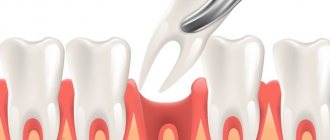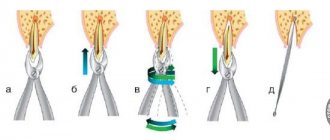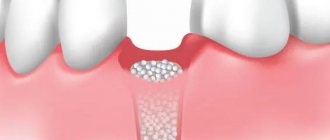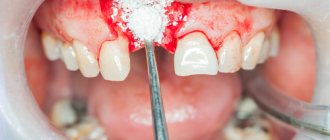Also watch: Important questions about anesthesia and sedationTeeth extraction under sedationCost of sedationWhat is drug-induced sleep in dentistry
For many people, dental implantation is the most reliable and optimal option for restoring the dentition. There are several types of dental implantation, the fastest of which is considered to be one-stage implantation. The peculiarity of this manipulation is that tooth extraction and implant installation occur immediately one after the other during one visit to the dentist. It is when carrying out this type of intervention that painless tooth extraction before implantation, delicate and non-traumatic, is of great importance. Failure to comply with the tooth extraction technique before immediate implantation can become a serious obstacle to performing this procedure.
Also, minimal trauma during tooth extraction is important before other options for dental implantation, as well as before osteoplastic surgery. Modern dental clinics offer their patients quick and painless tooth extraction using modern equipment and painkillers. Non-traumatic tooth extraction and the absence of pain in the patient are prerequisites for successful subsequent implantation and prosthetics.
In what cases is simultaneous implantation indicated?
The main indication for simultaneous dental implantation is the loss of one or more teeth, provided that an important condition is met, namely, maintaining the required volume and strength of the jaw bone.
It is recommended to perform one-stage implantation with preliminary tooth extraction when:
- Traumatization, when part of the tooth is damaged and it is not subject to conservative treatment. As a rule, if you consult a dentist in a timely manner after an injury, the bone tissue does not have time to undergo pathological changes and simultaneous implantation is possible with non-traumatic and painless removal of the injured tooth;
- Advanced stages of caries, in which the inflammatory and destructive process does not affect bone tissue. If conservative methods of caries treatment cannot help the patient (most of the tooth crown is destroyed), then it is best to carefully remove the tooth and perform a one-stage implantation;
- The need to restore the dentition as quickly as possible. Single-stage implantation is considered the operation of choice for patients whose professional or social activities require constant contact with people, and therefore require an appropriate appearance. The efficiency of the procedure is the main advantage of one-stage implantation among other methods of dental restoration;
Tooth extraction followed by implant installation is possible only if several important conditions are met. In addition to the absence of atrophic processes in bone tissue, complete sanitation of the oral cavity and the absence of symptoms of inflammatory gum diseases and other dental pathologies are necessary. Therefore, in addition to delicate and low-traumatic tooth extraction before implantation, it is also important to comprehensively prepare the patient for the intervention in order to obtain the desired result from implantation and minimize possible risks.
Do I need to remove uncut “eights”?
Not all people develop their “8s” by the right age. Sometimes they remain in the anlage, that is, retained (not erupted). When to remove them:
- if on an x-ray we see that the wisdom teeth abut adjacent molars (seventh teeth). There is a risk that wisdom teeth will “eat” into an adjacent tooth inside the bone. And then you will have to remove 2 teeth.
- The pressure of the “eights” on neighboring teeth can cause caries of the root of the “sevens” - our main chewing teeth.
- If the wisdom teeth are large and there is no place for them in the oral cavity. There is a high risk that they will collide with the dentition, and a crowded position of the front teeth will appear.
- During implantation next to unerupted figure eights. It is worth removing the tooth so that it cannot damage the implant in the future.
When is an intervention not recommended?
Despite the fact that one-stage implantation is considered the most convenient way to restore the dentition, its disadvantages include the presence of a large number of contraindications:
- Atrophic processes in bone tissue in the intervention area;
- The patient has osteoporosis;
- Diseases of the blood coagulation system;
- Endocrine pathologies (decompensated diabetes mellitus);
- Immunodeficiency conditions;
- Inflammatory gum diseases (relative contraindication, that is, the procedure is possible after the patient has completed the full course of treatment);
If there is at least one of the above contraindications, installing an implant immediately after tooth extraction is impossible and another treatment option is selected. Also, the process of tooth extraction itself in cases where the patient has these pathologies requires a special approach and is performed in the most gentle manner possible.
Contraindications for removal
In some situations, urgent tooth extraction without pain is impossible; this procedure must be postponed to a more convenient period. Among them:
- Patient's pregnancy (1st or 3rd trimester);
- The presence of acute forms of various diseases;
- Radiation treatment;
- Diseases with local manifestations (herpes, HIV, fungus, stomatitis, syphilis);
- Mental illnesses;
- Blood diseases;
- Chemical treatment of cancer.
In such situations, it is better to choose the time to remove the tooth from the alveolus more carefully.
How is preparation carried out for tooth extraction and subsequent implantation?
Since the quality of implantation depends on how carefully the dentist removes the tooth, each patient is required to undergo thorough preparation for this procedure, which includes a preliminary examination and some preparatory manipulations:
- The degree of tooth destruction, the presence or absence of structural anomalies in the implantation area are assessed;
- Additional instrumental research methods are carried out: X-ray, CT. With their help, the doctor assesses the condition of the bone tissue, as well as the roots of the tooth, including their location in relation to the paranasal sinuses;
- Instruments for tooth extraction and the optimal method of pain relief for the patient are selected;
- A set of treatment measures is prescribed in the presence of concomitant dental pathologies;
- If necessary, professional teeth cleaning is performed, which can effectively reduce the risk of infectious complications during the rehabilitation period;
- The day before tooth extraction, in many cases antibiotic therapy with a broad-spectrum drug is prescribed;
Before tooth extraction, it is also very important to ensure the correct psychological attitude of the patient. To do this, the doctor must explain to the patient in detail how the procedure will be performed, why certain manipulations are performed, and what results should be expected after tooth extraction and implant installation. In addition, the patient must be explained what kind of anesthesia will be used during the operation and how it works.
A special place in preparation for tooth extraction is occupied by sedation of the patient. To conduct mild sedation, the doctor must take into account the psycho-emotional characteristics of the patient, the degree of his anxiety before the upcoming manipulation. In modern dentistry, safe and effective drugs are used to provide sedation, which quickly eliminate such undesirable manifestations as severe fear, psychomotor agitation and others. Without proper psychological preparation of the patient and well-chosen sedation, painless tooth extraction before implantation is very difficult to carry out delicately and non-traumatically.
How to remove a tooth without pain?
In modern dental practice, tooth extraction is not carried out without high-quality, reliable and safe anesthesia for the patient’s health. In the vast majority of cases, when removing teeth, local anesthesia is used, that is, the patient remains conscious both during pain relief and during further manipulations. To remove a tooth, dentists most often resort to the injection method of local anesthesia, when an anesthetic is injected into the desired area of tissue by injection. Using the injection method, infiltration and conduction local anesthesia can be performed, while conduction anesthesia is more suitable in cases where several teeth are to be removed at once.
To remove a tooth without unnecessary trauma to the surrounding tissues and without severe stress for the patient, it is necessary to select an effective painkiller. The most common are drugs based on novocaine, lidocaine, ultracaine and some other anesthetics. The main requirements for drugs for local anesthesia are a rapid onset of effect, reliability and a high safety profile.
Before anesthesia, a special sensitivity test to the anesthetic must be performed. This is necessary primarily in order to exclude the development of such severe allergic complications as Quincke's edema and anaphylactic shock. After the dentist is convinced that the drug is safe to use, they proceed directly to pain relief. Several injections are made into the gums, and the patient may notice minor soreness and discomfort, which pass fairly quickly. After the anesthesia begins to take effect, careful tooth extraction begins.
When can you pull out a child’s baby tooth at home?
Changing teeth is a natural and necessary process of development of the maxillofacial apparatus. The peculiarity of the structure of milk jugs is that they have short nerve roots, which makes their loss painless. In most cases, changing milk jugs occurs independently and does not require outside intervention. It is possible to remove a temporary tooth in cases where it is well loosened, but at the same time it interferes with speaking and chewing. In such situations, it is permissible to carry out the manipulation at home without visiting a doctor.
How to understand that you can pull out a child’s baby tooth:
- there is no pain or blood when the milkman staggers;
- healthy pink gums;
- the tooth moves easily back and forth in the hole;
- no stomatitis, gingivitis, tonsillitis;
- The child feels well and is healthy.
What is needed to prevent injury during tooth extraction?
The correct selection of instruments for tooth extraction before implantation is necessary in order to minimize the risk of trauma to the bone and soft tissues surrounding the tooth. Since even the slightest injury to the alveolar process of the bone makes it impossible to carry out implantation immediately after tooth extraction, dentists use exclusively modern equipment to make the process of tooth extraction as precise and non-traumatic as possible. These include:
- High quality tongs. Selecting the desired shape and bend of the forceps and using them carefully allows you to remove the tooth and tooth roots without injury;
- Periotomes. Used for atraumatic tooth extraction with delicate separation of marginal gums;
- Luxators. They are an improved version of classic elevators, significantly simplify the process of tooth extraction and make it less traumatic;
- Ultrasonic surgical devices, for example, piezotome. Allows you to minimize trauma during tooth extraction and facilitates the rehabilitation period for patients after implant installation;
The quality of the instruments determines how convenient it is for a specialist to perform the operation, which in turn is of great importance for preventing injury to bone tissue and obtaining a good result from dental implantation.
In addition to choosing the necessary tools, the experience and qualifications of the specialist are of great importance.
For an average surgeon, the remains of teeth before surgery are a hindrance and are not treated on ceremony. The result is broken bone structures of the jaw, wandering remnants of roots, unremoved cysts growing into the maxillary sinus, perforations, fistulas, osteomyelitis and much more. Not to mention the shocking post-operative pain that overtakes the patient after such punitive surgery. Entrust removal to an oral and maxillofacial surgeon. Only the maxillofacial surgeon has enough theoretical and practical skills to perform tooth extraction without complications.
General information.
There are two types of tooth extraction - simple and complex. They differ in the method of extraction and the use of different tools.
Simple.
It takes no more than 15-20 minutes. First, the doctor injects an anesthetic, then slightly loosens the tooth and uses special forceps to pull it out.
Chronically, periodontitis is an inflammatory process that destroys the functions of hard and soft tissues. Because of this, the tooth’s support and connection to the gum are disrupted and it becomes mobile. It will not be difficult for a doctor to remove it.
If the patient seeks help late or there is simply no opportunity to restore and cure the diseased tooth, in this case, all that remains is to pull it out. After this, the doctor performs a curettage procedure (cleansing the hole of pus), disinfects the wound and the oral cavity.
Complex (surgical).
Removal of: impacted, dystopic, fused with bone tissue, or acute chronic tooth disease requires staged surgical intervention using special equipment.
A tooth that has not fully erupted, or has not erupted at all, due to its irregular location, is called impacted. Most often, this problem concerns the third molars, but other units of the jaw system are not immune from this phenomenon. Sometimes, cutting the gum hood and further releasing the crown helps correct the defect, but most dentists resort to an extraction procedure. It is necessary when there is a risk of displacement of the remaining teeth relative to each other or the appearance of inflammatory processes. Extraction of “eights” requires preliminary preparation. To access the crown, the doctor cuts through the soft tissue and drills a hole in the bone. If the molar has reached a large size, it is cut into several parts and pulled out with special forceps. At the end of the operation, the oral cavity and wounds are treated with antiseptic agents.
Removing a dystopic (incorrectly located) tooth will be no different; it also includes several stages.
The development and extraction of wisdom teeth deserves a separate topic. This is a vestigial organ that has lost its significance in the process of evolution. Basically, they appear at the age of 12-26 years. The patient may not even realize that he has an eighth tooth in the row, since its presence in the jaw is difficult to feel or notice. Its development occurs almost asymptomatically. But that doesn't mean it doesn't cause problems. When the time comes and the third molar begins to erupt, the patient may experience inflamed gums, an increase in body temperature and constant pain.
Those who have tried to remove a wisdom tooth know how difficult and painful it is. But thanks to the use of modern painkillers, the patient does not feel anything at all. There is a difference in the extraction of the upper and lower rows of the dental system. The lower “eights” are much more difficult to pull out, due to their massive roots and dense soft tissues, so the difference in cost is quite justified.
Before the operation, an x-ray and anesthesia are taken, after which the dentist pulls out the tooth and places sutures at the extraction site.
Another procedure that is performed using only surgical treatment is called apex resection. It is required when the patient has an infectious disease and a cyst forms. The operation is carried out in several stages. First, the doctor must give an injection with anesthetics. The surgeon cuts the gum and bone tissue for an unhindered approach to the tumor. Carefully removes the cyst by cutting off part of the apex of the tooth root. Cleanses the wound from purulent residues and disinfects it. To restore and fill empty space in the bone, artificial synthetic material is used.
Complex extraction differs from simple extraction by the use of completely different devices and stronger painkillers. Often, the doctor has to perform complex surgical procedures, cut the gums, apply sutures and much more.
Modern dentistry has numerous possibilities, one of them is prosthetics. If a patient wants to restore a lost tooth with an artificial crown, an important condition will be the preservation of the bone and soft tissue around the hole. If something has been damaged, a restoration procedure is required. Therefore, you should choose clinics with a good reputation and trusted specialists who can perform the extraction efficiently and painlessly, regardless of its complexity.
Main stages of the intervention
Tooth extraction is a routine procedure for an experienced dentist. After carrying out a set of preparatory measures and pain relief, the doctor begins to directly remove the tooth. In most cases, the tooth extraction procedure consists of detaching the gums using a special tool, applying forceps to the tooth, and then gently loosening it. After the tooth becomes sufficiently mobile, it is removed from the socket, which is then carefully examined to prevent the presence of bone fragments in it. The final stage is the treatment of the tooth socket, the main purpose of which is to prevent infectious complications.
Sometimes complex tooth extraction may be necessary before implantation. This procedure is resorted to in cases where there are anomalies in the structure of the dentition or severe curvature of the tooth roots. For complex removals, the dentist uses additional instruments and the intervention requires a little more time. If the tooth extraction was atraumatic, the doctor begins the implantation procedure.
Removal procedure
With the passage of time and the development of medical technology, the extraction technique has not changed at all. Of course, this is not one of those barbaric methods that were used in ancient times. Today, teeth are removed using forceps. There is simple and surgical removal, the first of which is necessary if the doctor has the opportunity to catch the instrument on the tip of the tooth that remains protruding from the gum.
The second is when the doctor has nothing to take on. Such situations require an integrated approach, in which various deposits on the surface of the teeth are eliminated using ultrasound equipment, then removed, and then antibiotics are prescribed to treat the “wound.”
This procedure no longer causes fear and horror in the eyes of patients. If you trust an experienced professional specialist, you can quickly and comfortably remove a tooth without pain, without hurting other teeth. It is important to always monitor the condition and health of the oral cavity in order to repair, rather than remove, teeth.
Do you need a dental surgeon? Call now
+7
Why is it important to adhere to the low-impact principle?
Minimizing trauma to healthy tissues surrounding the tooth is a priority when removing a tooth of any degree of complexity. However, if this procedure is carried out immediately before implantation, then delicate and low-traumatic tooth extraction is necessary not only to protect the patient from unpleasant sensations, but also so that the dentist can reliably fix the implant in the bone tissue.
It is also very important to prepare the patient for the procedure, which, in addition to a comprehensive examination, may include mild sedation to eliminate psycho-emotional discomfort.
Sincerely, Levin D.V., chief physician
The following problems are typical for wisdom teeth:
- Development of caries or inflammation of soft tissues;
- Lateral growth causing injury to the oral mucosa, tongue and gums;
- Destruction of adjacent teeth due to improper growth of wisdom teeth;
- Severe pain due to the proximity of the facial nerve;
- Purulent lesions in the projection of the 8th tooth.
The cost of wisdom tooth removal is affordable for everyone. But the most important thing is the professionalism of doctors. Competent specialists work in our clinic. You can make an appointment with them today and solve your problem!











